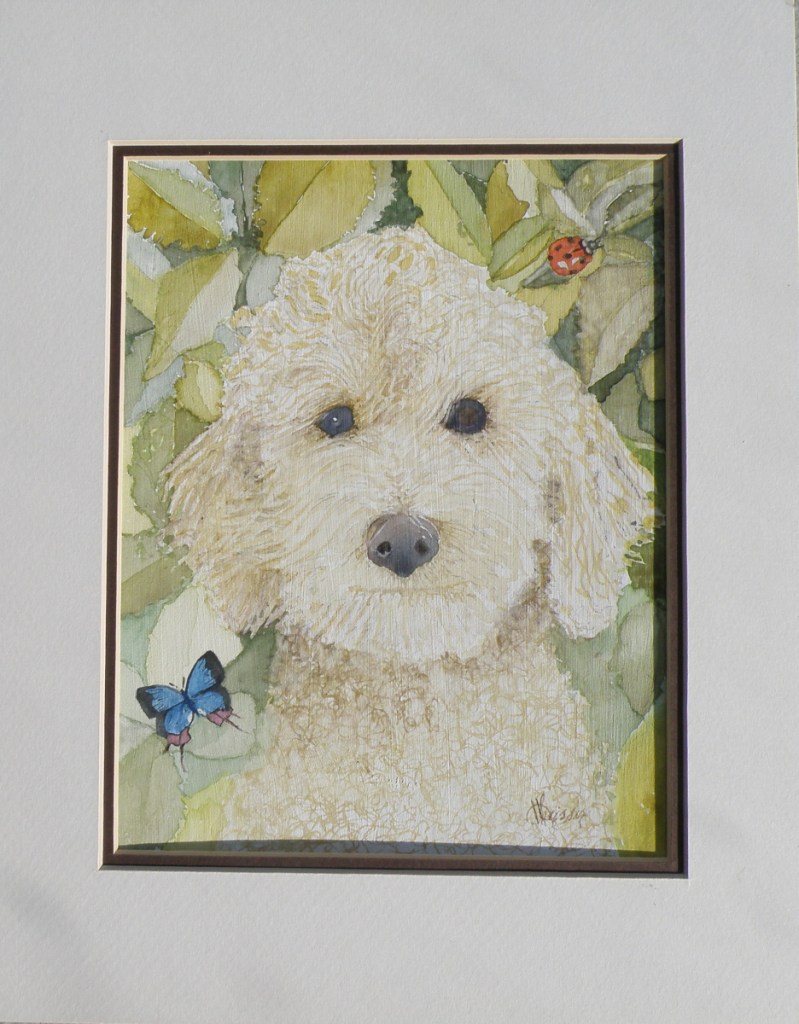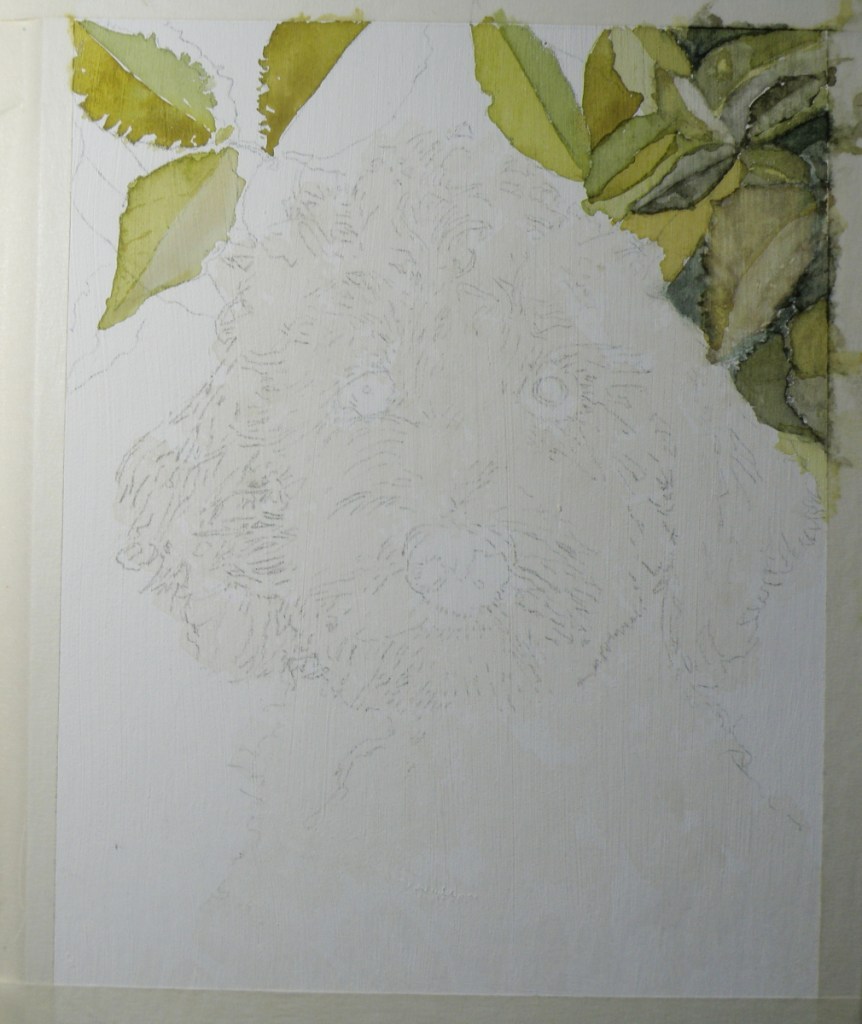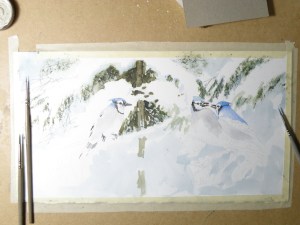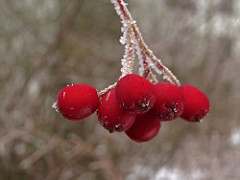Painting Progression 4: Juno, finished
March 9, 2021
While painting this portrait of Juno in honour of Kathie’s birthday, our little Bichon, ‘Elmo’, was in the final days of his thirteen-year-old life. Stoically dealing with a heart twice its normal size, an enlarged liver and kidney malfunction, our beloved ‘Elmo’ passed away in his bed just after I’d checked on him on January 24th. For his two daddies, this was a sorrowful occasion and one very difficult to get over.
As the weeks passed, however, we realised we needed to at least try to fill the emotional hole of losing our lovely pet and began searching far and wide for a new puppy. At the same time, I was close to finishing the portrait of Juno and finally did, a couple of weeks before Kathie’s big day:
Kathie and Ken were very pleased and the Juno portrait now hangs in their dining room.
And we–Raul and I–have a new addition to our family, a tiny toy Maltipoo puppy named ‘Ashton’, who can never replace ‘Elmo’ and yet has won us completely over by his beautiful perky cuteness and charming personality:
Painting Progression: Juno
March 5, 2021
To help celebrate the birthday of a recently retired Occupational Therapist and good friend–Kathie–her spouse, Ken, the Dean of our local Anglican Cathedral, provided me with photographs of their very charming one year old Labradoodle dog, Juno. My hope was to present Kathie with a watercolour portrait of Juno to mark her upcoming, significant ‘0’ birthday,
Dog portraiture is not something I have experience with/in. And Juno being from a breed known for its gorgeous curls and wavy hair/fur, presented challenges I wasn’t convinced my experience with watercolour could overcome. Fortunately, this painting was one I offered to do, and so if it was beyond my abilities I simply had to say so and produce a watercolour of another subject I knew Kathie would enjoy receiving.
I started with a detailed drawing:
Because Juno’s place to be is anywhere outdoors, I decided to provide a rosebush background.
Cloud Studies
July 21, 2020
Sometimes there’s a need to trample on whole bunches of internal dos and don’ts, accumulated over years of anal retentive watercolour practices.
‘Don’t premix washes–glaze one pigment over another right on the paper’; ‘Don’t soak the paper in the bathtub and then stretch it on a stretcher–it removes the lovely sizing’; ‘Don’t get obsessed with detail–be expressive’; ‘Don’t use opaque white’; ‘Don’t use so much masking fluid’; ‘Don’t be so timid’; ‘Don’t paint today–you aren’t centred’.
Lordy. I went to the sink, grabbed a kitchen sponge and some dollar store poster board.

For all who might be equally plagued by a mental build-up of watercolour dos and don’ts, have a look at this example of watercolour exploration and artistic daring:
Sky Positioning and Treatment II
July 1, 2020
Just as choosing to place one’s subject matter in front of bright sky produces remarkable effects as in the work of Joseph Zbukvic, so also can equally-remarkable effects be achieved when making the sky itself the subject.
An almost unparalleled master is a lesser known watercolourist than the celebrated J. Zbukvic, but a truly exquisite painter of both sea and sky, the Russian Sergey Temerev:
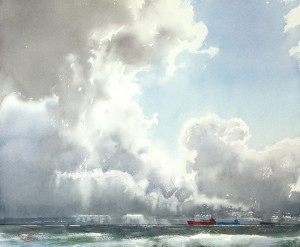


Here is a video of him at work:
Now, those are clouds.
When one reads about the long life of Jean Sibelius and how he had such a strong affinity for nature, for Autumn and Winter in particular, and was, after all, a Finn, whose country embraces the colder months, it seemed fitting to depict Sibelius Square in November. His biographer wrote this:
“. . . Even by Nordic standards, Sibelius responded with exceptional intensity to the moods of nature and the changes in the seasons: he scanned the skies with his binoculars for the geese flying over the lake ice, listened to the screech of the cranes, and heard the cries of the curlew echo over the marshy grounds just below Ainola [his home, named after his wife]. He savoured the spring blossoms every bit as much as he did autumnal scents and colours. . . “
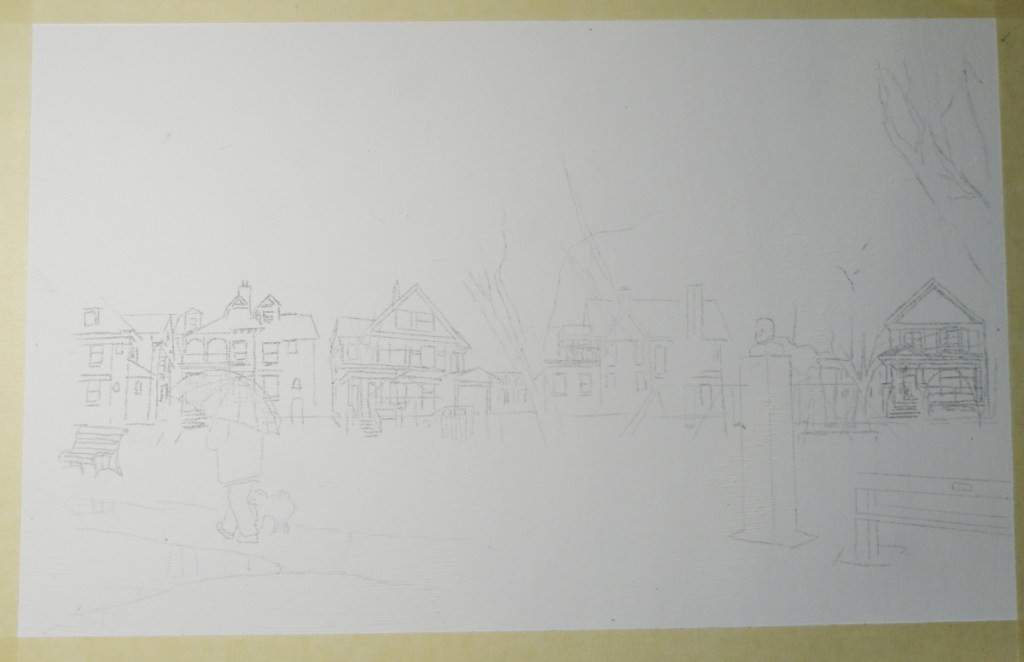
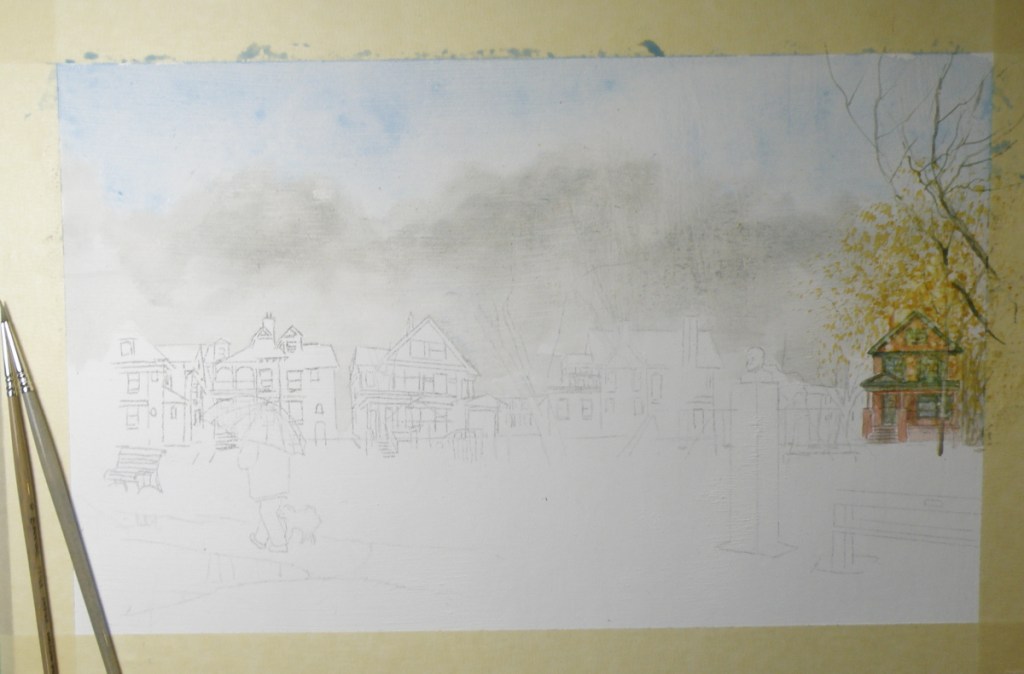

The distinctive, late 19th c. Toronto architecture of the area known as The Annex is unabashedly Victorian, boasting ‘some of the largest collection of Victorian houses in North America.’
‘During this period Toronto also developed some unique styles of housing. The bay-and-gable house was a simple and cost effective design that also aped the elegance of Victorian mansions. Built of the abundant red brick, the design was also well suited to the narrow lots of Toronto.’ [wikipedia: The Architecture of Toronto]

In The Annex, however, there was an elegance reserved only for those who could afford it. ‘Built by the city’s wealthy and mostly found in the neighbourhood they are named after, these houses contain diverse and eclectic elements borrowed from dozens of different styles. These houses are built of a mix of brick and sandstone, turrets, domes, and other ornamentation abound.’ [ibid.]

In this painting, some decisions had to be made as to whether it was going to be about the houses surrounding The Jean Sibelius Square Park, or about the monument dedicated to the composer, or about the overall mood of late Autumn and how it informs the architecture, the park and what Sibelius himself loved about November.
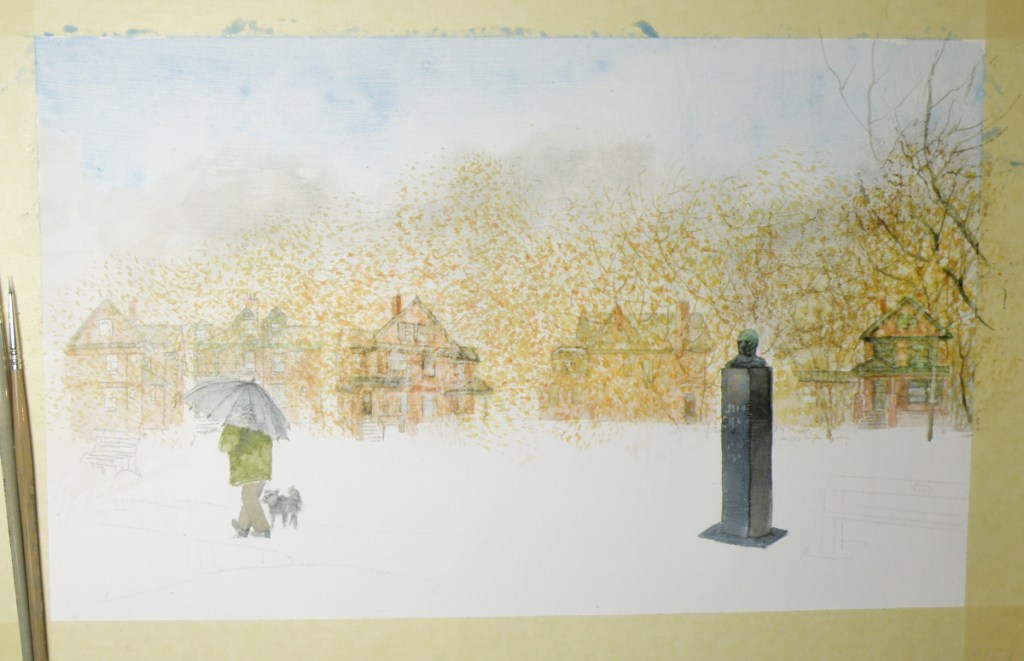
Finished Painting: ‘Raven Winter’
February 16, 2018
It is snowing again, and is likely to continue through today and tonight and into tomorrow. As my friend Shiela says, snow today is water tomorrow, meaning we live in a characteristically arid part of British Columbia (our backyard mountain ridge has many cacti plants) and so every source of water is cherished. The snowmelt from the mountains is crucial to ensuring our lifeline, the Thompson River, is of normal size.
Around here, many people kind of roll their eyes and sigh when learning we’re getting another ‘dumping’, but I’ve always delighted in snow and can now sadly envision a day when there won’t be any. Our living situation is such that I can handle clearing the driveway without much effort, otherwise I might be joining one of the eye-rolling crowd.
Here is the painting ‘Raven Winter’ that is now framed and ready to be presented to my friend Patricia Kellogg as a possible choice in our painting exchange deal:

‘Raven Winter’, watercolour on treated art board, 9″ x 12″
Stage Two: ‘Raven Winter’
February 14, 2018
The painting for my friend Patricia Kellogg is taking shape. The treated surface of the mat board I’m using to paint on was/is achieved by applying a product by Daniel Smith called ‘watercolor ground’. It comes in a jar and is painted onto any surface one desires, instantly turning it–once allowed to thoroughly dry–into one which can be painted on using transparent watercolour. So, glass, metal, wood, masonite, anything of the kind can basically become a surface with the characteristics of watercolour paper.

Stage Two: Waxwing Watercolour
February 5, 2018
1) They are named Waxing because they sport red wax-like accents on the tips of their secondary feathers;
2) Although they eat insects during Summer months, they thrive on berries the rest of the year and, in our part of British Columbia, go about in groups to feast on Mountain Ash berries;
3) If there is a cluster of berries hanging from the tip of a long branch that only a single bird can reach, sometimes the rest of the group will line up and pass berries beak-to-beak down the line allowing each bird the opportunity to feed.
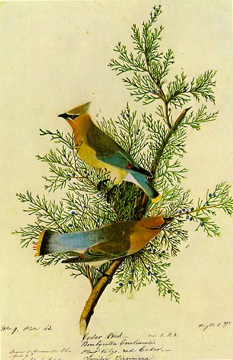
Audubon Print
Its fondness for the small cones of the eastern red cedar is why this particular Waxwing is called ‘Cedar’ Waxwing. (My first post is mistaken in assuming they are not found in Eastern N. America. They are–but I just wasn’t privileged to spot any when growing up in upper New York State.)
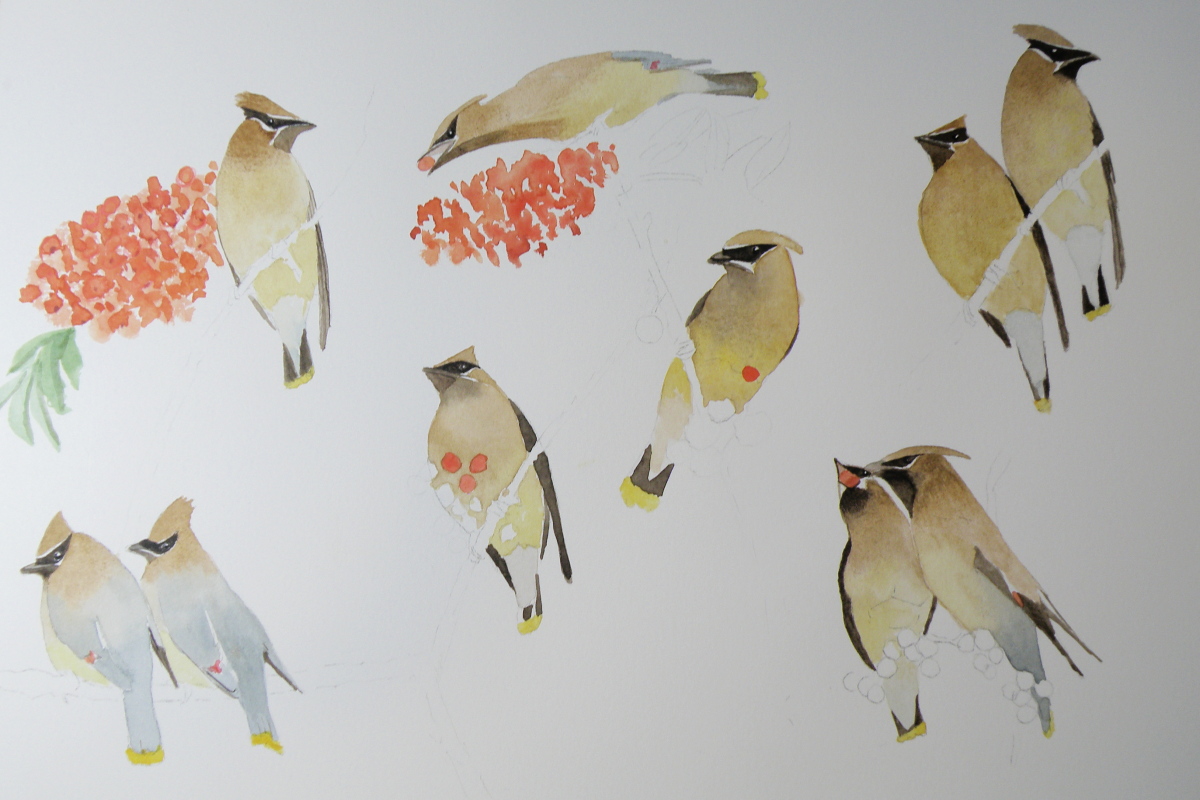
Cedar Waxwing watercolour-in-progress, Saunders Waterford Hot Press Paper 140 lb.
[above facts gathered from Cornel Ornithological and Wikipedia websites]
…..blue jays and mountain ash, stage 1
October 25, 2015
One Jay we do not have in the West is the Blue Jay. The ‘why’ of this is puzzling simply because the weather and climate here rather mirror that of Eastern Provinces and States (minus the humidity, thank heaven).
As annoying as this bird can be, the sheer pleasure it appears to take in creating continuous drama — the screeching cry it passes off as ‘song’ turns the lovely silence of a Sunday morning into a birdie alarm clock — makes the Blue Jay an attention receiver (like that kid you always remember from Grade 4).
And….the Blue Jay–like most Jays–is beautiful.
Their blue, black and white colouration is as dramatic as the Blue Jay personality. They have the ability to turn any bird feeder situation into a Three Stooges food fight. And for all these reasons, make a great subject for painting.
A favourite natural food in Winter is the Mountain Ash berry.
These trees are in abundance here in Southern British Columbia, and grow very large, and are responsible for allowing the N. American Robin to return very early–often at the end of February–sustaining them until the ground becomes warm enough for pursuing worms.
Choosing both Blue Jays and Mountain Ash in Winter makes for great contrast in colour, and a lively composition for painting.
Now we’ll just have to see how it all turns out….
